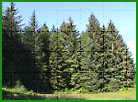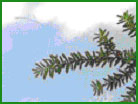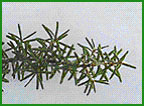|
|
Tongass National Forest

The Tongass National Forest is the largest National Forest with almost 17 million acres. It’s a forest of islands and trees and rain—lots of islands and trees and rain. It also abounds in animals and birds and fish, with unsurpassed scenery and hardy people. It's a place where eagles are commonplace, almost every road is a deer crossing, and bears use the trails, too. The Tongass is a wild place, where the natural world is a strong presence that nurtures spiritually and materially and demands respect.
Tongass Forest Service employees work to balance the multiple uses of the forest resources. Tongass has healthy fish and wildlife populations, clean water, trees to support local industry, recreation opportunities unique to Alaska, and plenty of unspoiled beauty and solitude. What roads exist in Southeast Alaska have been developed from forest roads built to reach timber.
The Common Conifers of Southeast Alaska
The temperate rain forest of the panhandle of Alaska is widely known for its lush vegetation. Conifers, cone-bearing trees such as hemlock, and spruce, seem to be everywhere. In reality, they cover a bit over half of southeast Alaska. Western hemlock (70 percent) and Sitka spruce (20 percent) are the most abundant. Western red cedar, yellow-cedar, mountain hemlock, and shore pine make up most of the rest.

Sitka spruce (Alaska's state tree)
Picea sitchensis
Leaves -- dark green, 5/8 to 1 inch long, needle sharp, growing in all sides of branches from woody pegs (a trait common only to spruce)
Cones -- light orange-brown, 2 to 3 1/2 inches long, usually found in the top quarter of tree, hanging down from branches, papery scales
Bark -- thin and smooth, developing scaly plates with age, gray, becoming dark purplish brown with age
Size at maturity and lifespan -- 150 to 225 feet in height and 5 to 8 feet in diameter, grows much larger in the southern part of its range, 500 to 700 years
Distribution -- sea level to 3,000 feet elevation in Southeast Alaska, throughout Southeast Alaska, west to Kodiak Island and north to the coast of the Alaska Peninsula
Both species of hemlock have very thin branches and tops that curve downward and appear to be gracefully nodding. In the spring, new vegetation bursting from the buds is bright yellow-green. Here's how to tell them apart:

Western hemlock
Tsuga heterophylla
Leaves -- light green to medium green on top, with two whitish parallel lines beneath, 1/4 to 7/8 inch long,
blunt-tipped, soft, shiny, and flat, growing from two sides of branch parallel to the ground
Cones -- brown, oval-shaped, 5/8 to 1 inch long; thin, papery scales; hanging down at end of twig
Bark -- reddish-brown when young, turning gray-brown; scaly when young, becoming thick and furrowed with age
Size at maturity and lifespan -- 100 to 150 feet in height and 2 to 4 feet in diameter; 200 to 500 years
Distribution -- sea level to subalpine areas; throughout the coastal forest of Southeast Alaska and north to Prince William Sound

Mountain hemlock
Tsuga mertensiana
Leaves -- dark blue-green; 1/4 to 1 inch long; soft but more pointed than western hemlock; growing from all sides of the branch in a starlike pattern
Cones -- purplish when new, brown when mature; cylindrical; 1 to 2 1/2 inches long; thin, papery scales
Bark -- divided into narrow flattened ridges; becoming thick and deeply furrowed with age; gray when young, turning reddish brown with age
Size at maturity and lifespan -- 50 to 100 feet in height and 10 to 30 inches in diameter; prostrate near timberline;
slow-growing trees; size 18 to 20 inches in diameter at 180 to 260 years; 400 to 500 years
Distribution -- sea level to 3,000 to 3,500 feet elevation; throughout Southeast Alaska

Shore Pine
Pinus contorta Dougl. var contorta
Leaves -- yellow-green to dark green; 1 to 2 1/4 inches long; two leaves, each a half-round, bundled together, making a circle when pressed together
Cones -- light brown; egg-shaped; 1 1/4 to 2 inches long; pointed backwards on branches; woody, with stiff prickles on the end of each scale
Bark -- resinous and scaly, becoming furrowed with age; dark brown to blackish
Size at maturity and lifespan -- often a small, scrubby tree; 20 to 40 feet in height and 8 to 12 inches in diameter; sometimes 75 feet in height and 18 to 32 inches in diameter on well-drained, sunny sites; 200 to 600 years
Distribution -- especially in coastal muskegs; sea level to alpine zone; throughout Southeast Alaska, north to Yakutat
Both species of cedar have scale-like needles that look like braided hair. The needles are small, pointed, smoth, and flattened tot eh branch. Though commonly called cedars, they are members of the cypress family. Yellow-cedar, also known as Alaska cedar, is named for its bright yellow heartwood, and western redcedar, for its deep reddish brown heartwood. Both are aromatic and highly resistant to rot. Here's how to tell them apart:

Yellow-cedar
Chamaecyparis nootkatensis
Leaves -- dark green; 1/16 to 1/8 inch long
Cones -- patchy green and black, nearly round; 1/2 inch in diameter; scattered among the needles;
sharp central point on each cone scale
Bark -- shreddy; generally ash gray
Size at maturity and lifespan -- 40 to 80 feet in height and 1 to 2 feet in diameter; slow-growing trees; 15 to 20 inches in diameter at 200 to 300 years; up to 1,000 years
Distribution -- muskegs, alpine meadows, and nearby forests of Southeast Alaska as far north as Prince William Sound; sea level to timberline in Southeast Alaska, though mainly at elevation of 500 to 1,200 feet; common in northern Southeast Alaska scattered in southern Southeast
Western redcedar
Thuja plicata
Leaves -- shiny yellow-green; 1/16 to 1/8 inch long; springy, fan-shaped branches, turning up at the ends
Cones -- brown, oval-shaped, 1/2 inch long; clustered near end of branches; cone scales woody and curve outward at maturity
Bark -- fibrous and stringy; cinnamon-red when young, becoming gray with age
Size at maturity and lifespan -- 70 to 100 feet in height in Southeast Alaska (growing much taller in souther part of range); 2 to 4 feet in diameter (occasionally reaching 6 feet); 300 to 700 years (occasionally 1,000)
Distribution -- found in coastal forests in Southeast Alaska; sea level to 3,000 feet elevation; southern Southeast Alaska to just north of Sumner Strait
Other Conifers in Southeast Alaska
Four other species of cone-bearing plants are found in Southeast Alaska. Common mountain juniper (Juniperus communis) is a low-spreading evergreen shrub that grows in muskegs, and on dry slopes and rock outcrops in alpine or subalpine areas. Two fir species -- Pacific silver fir (abies amabilis) and subalpine fir (abies lasiocarpa) -- are found in this region. The Pacific silver fir is mainly found east and south of Ketchikan on well-drained sites from sea level to 1,000 feet in elevation. The subalpine fir is most common in Misty Fjords National Monument, the head of Lynn Canal, and in areas of recent glaciation, such as valley bottoms, or on moist subalpine slopes near timberline. Pacific Yew (Taxus brevifolia) is rare in Southeast Alaska and found only in the most southern part of the panhandle.
What on Earth is Muskeg?
Like a soggy blanket draped over the landscape, muskeg, or peat bog, covers more than 10 percent of southeast Alaska. It provides a surprisingly fragile home for an abundance of plants that thrive in the wet, acid soil. During the summer, the flowers on many of them add a carpet of soft color to the muted greens and browns typical of muskeg.
Muskeg itself consists of dead plants in various stages of decomposition, ranging from fairly intact sphagnum peat moss or sedge peat to highly decomposed muck. Pieces of wood, such as buried tree branches, roots, or whole trees, can make up 5 to 15 percent of the soil.
The water level in muskeg is usually at or near the surface. Stepping on muskeg is like stepping on a sponge, and walking across it involves avoiding the multitude of open ponds that range in size from potholes to small lakes. Despite their innocuous appearance, muskeg holes can be more than just messy - they can be dangerous. Some are quite deep and offer no toeholds to help the unwary climb back out.
Sphagnum moss is the mainstay of muskeg. It soaks up and holds 15 to 30 times its own weight in water. In the process, it keeps water from draining through the soil. So muskegs can form even on relatively steep slopes, especially in Southeast Alaska's cold wet climate.
Muskeg is so wet, acid, and infertile that about the only trees that grow in it are a few stunted shore pine (Pinus contorta). These may grow only 5 to 15 feet high and less than 10 inches around in 300 to 400 years.
Muskegs need two conditions to develop: abundant rain and cool summers. A dead plant that falls on dry soil is attacked by bacteria and fungi and quickly rots. If that plant lands in water or on saturated soil, though, it faces a diffferent fate. Air can't get to it, so the bacteria and fungi can't function well. The cool temperatures slow them down even more. All this slows decomposition, and the plant debris accumulates to form peat and eventually, a muskeg.
Additional Resources
To learn more about Tongass National Forest and the temperate rain forest, click on these pdf files:
For more information, go to http://www.fs.usda.gov/tongass/.
|








